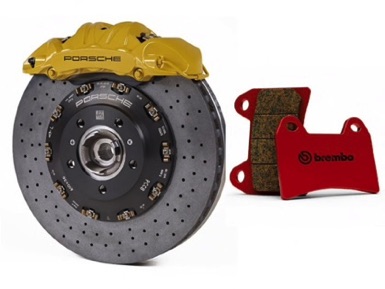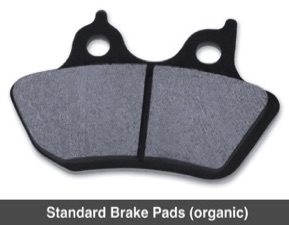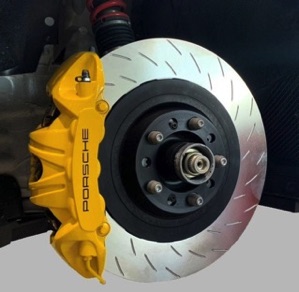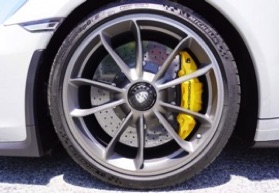Published in the March 2022 issue of “Die Porsche Kassette”
Ⓒ2016 Technolab / PedrosGarage.com

For more information about ceramic brakes and more, please visit my website:
www PedrosGarage.com.
Happy Porsche'ing,

We’ve all heard about ceramic brakes, but what exactly is ceramic and why are they so expensive? Are they really worth the price? Are they really that much better?
We’ll try to answer each one of these questions that people always wonder about.
Generally when people talk about ceramic brakes they are referring to ceramic brake pads. I make the notation because there are also ceramic rotors (discs) both of which we’ll look at I detail.

Ceramic Brake Pads
Ceramic brake pads are manufactured from material very similar to the one use when making pottery and plates. The material used for the brakes is much denser and durable buy it also incorporates fine copper fibers mixed in with the material. These fibers help to increase friction (better braking) and also increase heat conductivity (cooler brakes).
Ceramic brake pads were developed in the 1980s and have been increasing in popularity ever since their introduction.
Compared to standard brake pads, ceramic pads are much quieter, giving off very little sound when the brakes are applied. They are also quite clean, meaning that there is much less brake dust and they also work better in a wider range of climatic conditions than standard pads.
They are more expensive than the metallic or asbestos-type pads and much less conductive than metallic pads allowing for heat to be transferred into the rest of the braking system.
Ceramic pads are not recommended for extreme cold weather and they’re intended to be used with standard cast iron rotors.

Ceramic is very heat-resistant, up to 1,000˚C (1,832˚F), therefore ceramic composite brake discs last up to 60 times longer than standard cast iron discs. Ceramic composite means that the ceramic material, silicone, is combined with carbon fibers for strength. In Porsche-speak they are called PCCB (Porsche Ceramic Composite Brakes).
The extremely complex manufacturing process begins by mixing a heat-moldable resin powder with finely chopped pieces of raw carbon fiber. This mixture is poured into an aluminum mold with the shape of the disc brake, filling it half way. Aluminum spikes (cores) are then fitted through the disc. These will form the ventilation channel once removed after the molding is completed. The mold gets another pour of the composite to fill it completely.
Once filled, the mold gets a lid while it moves into a press that will put 20,000 Kg (45,000 lb) of pressure while heating the mold and its contents to 200˚C (392˚F). This compacts the carbon fiber and transforms the resin powder into plastic. Then it’s time to cool down. Once the mold is completely cool it is opened and the disc is extracted. A computer-guided laser corrects any rough areas and makes ventilation holes on the disc (equivalent to cross drilling in cast iron discs). Now the disc goes back into an oven that gradually, throughout the course of two days, heats it to 1,000˚C (1,832˚F). This produces a chemical change that transforms the plastic into carbon. The disc then goes into a crucible (high heat resistant container). It is suspended from the bottom of the crucible by five mounts. A ceramic material (fine silicone powder) is poured into the center opening of the disc. The crucible and its contents then moves into another oven which gradually raises the temperature to 1,700˚C (3,092˚F) throughout 24 hours. This melts the silicone. Then it applies a low suction that draws the now melted silicone into the disc ring. This creates an extremely hard, new material, called silicone carbide. Once cooled, another laser-guided machine bores the mounting holes. The disc then gets submerged into a special protective paint that shields the carbon from contacting oxygen (anti-oxidation treatment) which significantly extends the life of the brake disc.
The paint is dried in an oven then the disc is cleaned and polished. Finally a computer carefully inspects the disc taking thousands of micron-level photos which are analyzed for imperfections. The last step is affixing the bell, the centerpiece that mounts to the wheel carrier.
The bell is made from aluminum or steel and is bolted onto the disc via the mounting holes previously bored into it.
Because of their better stopping power and longer life than cast-iron rotors, Porsche had initially recommended PCCBs for track use. When first introduced, we were told that the high price ($9,000 option on the Carrera S) was justifiable because the discs would virtually last for the life of the car, but people would wear them out after a few hard track days. What happened is that ceramic discs can degrade if you’re hard on the brakes in a track environment which allows for very little cool down time. So now, the consensus is that ceramic brakes are simply too expensive to replace when they wear out so most track junkies who had opted for PCCBs have replaced the discs with cast-iron discs.

PCCB conversion to iron rotors
So, what then are ceramic brakes good for?
They are perfect for people who don’t like cleaning their wheels. PCCBs drastically reduce the build-up of break dust.
PCCB discs weigh 50% of their cast-iron counterparts, so there is a great reduction of unsprung weight.
They also look very cool and if not tracked, should last the life of the car.


